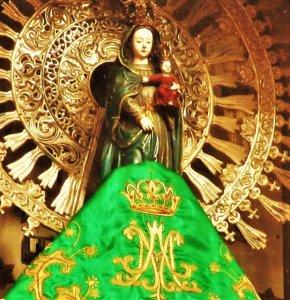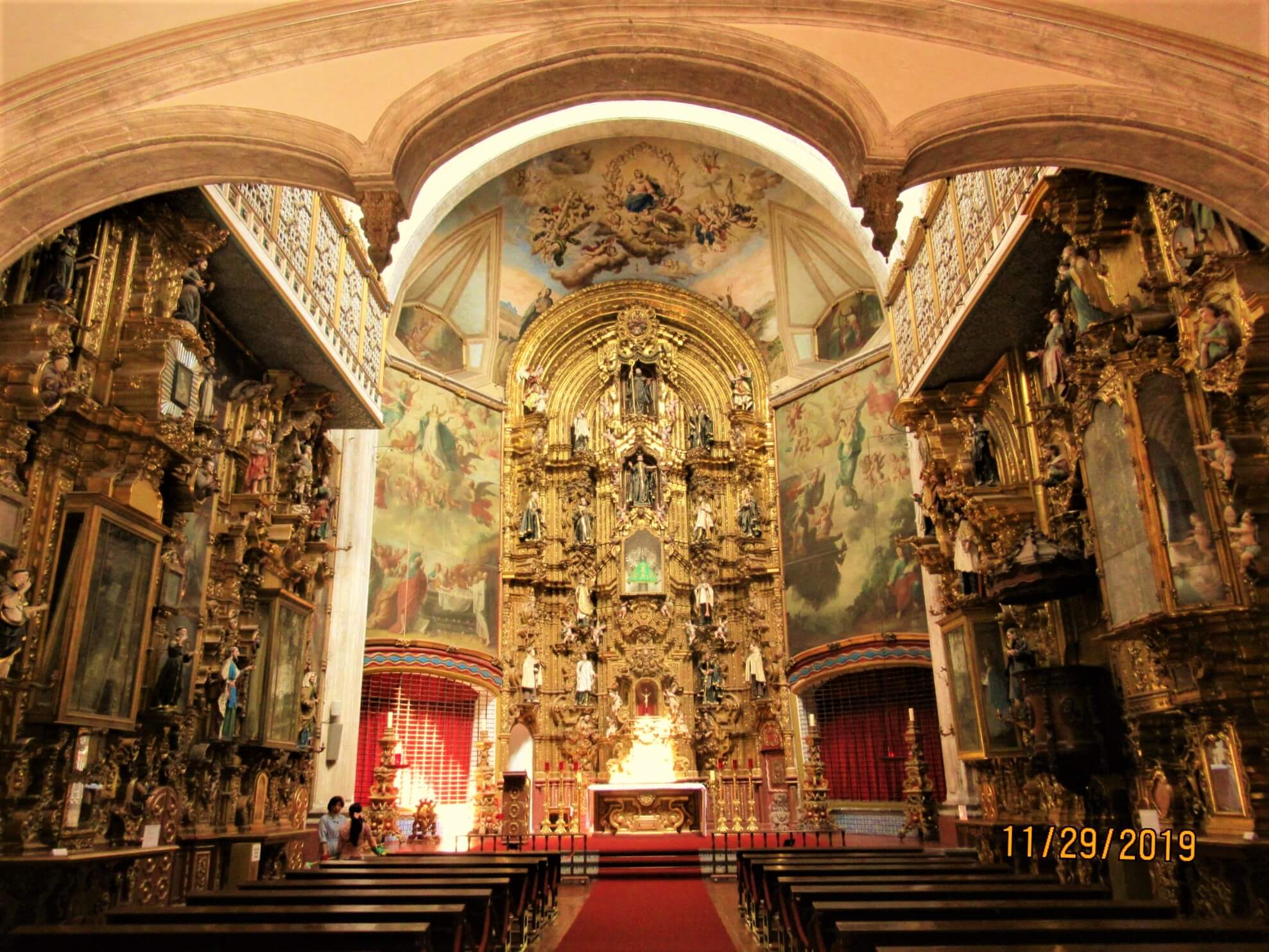“In fourteen hundred and ninety-two Columbus sailed the ocean blue,” a chant familiar to every school-aged child in the United States. Well, let us hope that this is still the case! It marks the event, of course, in which the Italian-born navigator, Christopher Columbus, departed from Spain and discovered the Americas. An event of enormous magnitude on so many levels, particularly for Christianity: It enabled the indigenous peoples in this new continent to receive the faith for the first time.
Columbus’ discovery opened the pathway for scores of others to explore the New World. One of these was the Spanish conquistador, Hernán Cortés. After he and his Indian allies conquered the Aztec Empire in 1521, the evangelization of Mexico by Spanish missionaries began in earnest. Mexico would eventually become one of the most Catholic of countries and hundreds of churches, monasteries, and convents would be built in the ensuing years.
One of these churches is that of La Enseñanza (pictured above), which is located in the central historical district of Mexico City. It is considered one of the most beautiful in the city and is a prime example of the Churrigueresque style of architecture, a style unique to Spain and Latin America, particularly Mexico.
It is named after the Spanish architect, Jose Churriguera, who dominated architecture in Spain for the first half of the 18th century. It is known as “ultra-baroque,” and is characterized by an extravagance of sculptural details; one author describes it as “a plethora of elaborate decoration.” Gilded rosettes, vines, clouds, angels, scrolls, statues and paintings adorn all wall surfaces in splendid array. All with one mystical purpose: To give glory to God with all one’s heart and soul! The church is dedicated to Our Lady of the Pillar.

It is named after the convent of La Enseñanza which was founded by Mother Maria Ignacia de Azlor whose goal was the education of young girls, a mission to which she dedicated her life. Enseñar is the Spanish word for “teach.” She died in 1767 and the construction of the church began a few years later. By 1778 the church was completed and was consecrated in the same year by Archbishop don Alonso Nunez de Haro y Peralta. The expulsion of religious by the anti-clerical Reform Laws resulted in the abandonment of the convent in 1861; the church, however, was preserved.
Ensconced above the main altar is the statue of Our Lady of the Pillar. She is holding the Child Jesus and is standing on a slender column which is partially obscured by a mantle. The origin of this statue is a wondrous study for anyone interested in the history of the Church!
Tradition relates that Our Lady appeared to the apostle, St. James, in the year 40 AD as he was sitting by the shores of the Ebro River in Zaragoza, Spain. Apparently, he was downhearted and discouraged by his missionary endeavours. So few were listening to his message! Our Lady came to encourage him and give him strength.
This apparition occurred while Our Lady was still alive. It is also the first and likely only account of Marian bilocation (in which a person can be in two places at once).
Such a mission of encouragement recalls incidents from the Old Testament. One is the scene from 1 Sam. 23:16-17 in which Jonathan came to provide reassurance and strength to a terrified David: “Jonathan came down to David (who was fleeing for his life from King Saul) and strengthened his resolve in the Lord.”
Another recalls a scene from the book of Joshua where a mightily disheartened Joshua (the Israelites had just suffered a significant military defeat) “lays prostrate before the ark of the Lord until evening” (Jos.7:6). The Lord appeared to him and said: “Joshua, stand up! Why are you lying prostrate? Rise. Sanctify the people! (Jos.7:10)
And who can forget the story of Elijah? An overwhelmed Elijah was praying to the Lord and asking to die. An angel came to him, not once but twice, and took charge. Literally! He ordered Elijah to get up and – eat! And Elijah became infused with strength (1 Kgs. 19:4-8).
Spanish mystic Venerable Mary of Agreda (1602-1665), an abbess at the Franciscan Conceptionist convent at Agreda, Spain, provides more details about this encounter between Our Lady and the Apostle, St. James. Agreda received mystical revelations concerning the life of the Blessed Virgin Mary and recorded these in her revered book, The Mystical City of God. Her body was exhumed in 1909 and was found to be incorrupt.
She reveals to us what St. James witnessed: He saw Our Lady sitting on a golden crown, accompanied by a thousand angels. “The angels carried a small statue of Our Lady and a pillar of marble” she wrote. One can just imagine the effect of this on the Apostle. Not just one angel but a thousand! And all accompanied by Our Lady herself.
According to Agreda, “all the solicitude of our great Mother and Lady was centred upon the increase and spread of the holy Church – and the consolation of the Apostles and disciples, in defending them from the persecutions and assaults prepared by the infernal dragon and his hosts.”
Our Lady knew that James would be the first of the Apostles to be martyred. He would, in fact, be beheaded in Jerusalem a year later. Acts 12:2 recounts this: “King Herod had James, the brother of John, killed by a sword.” St. James would become the patron saint of Spain.
Our Lady travelled to Zaragoza because Our Lord requested it, not only that she console the Apostle but that she have a church built in her honour at the site. This church, the Basilica of Our Lady of the Pillar in Zaragoza, Spain (with its original statue and column), would become the first church in Christendom to be dedicated to the Blessed Mother. Many Spanish saints such as St. John of the Cross, St. Teresa of Avila and St. Ignatius of Loyola were devoted to Our Lady of the Pillar and made pilgrimages to Zaragoza. In 1730 Pope Innocent XIII authorized the veneration of Our Lady of the Pillar throughout the Spanish empire. The feast day of Our Lady of the Pillar is October 12th.
It was in August, 1492 that Columbus sailed from Europe and by October, he had still not found land. He promised his men that if they had not sighted land by the feast of Our Lady of the Pillar, they would turn back to Europe. But on October 12th, 1492, they saw it.
Columbus discovered the Americas on the feast day of Our Lady of the Pillar. This is the same day that many countries in the Americas commemorate Christopher Columbus! (In the United States it falls on the second Monday in October).
Is this mere coincidence? Or is there, somehow, a mystical connection between these two events, separated from each other by some fourteen centuries?
In 1892 Pope Leo XIII wrote an encyclical, Quarto Abuente Saeculo, to commemorate the 400th anniversary of this epochal discovery. He said that (contrary to revisionist “historians”) Columbus “sought nothing from his enterprise but the increase and glory of the Christian religion.” Robert Royal, author of Columbus and the Crisis of the West says as well: “God played a large role in his conception of mission.”
The parallels between the two are striking:
- They occurred during times of grave crisis for the Church. The infant Church was suffering intense persecution as was the Church shortly after Columbus’ discovery: millions would be leaving the Church in Europe because of the Protestant Reformation.
- Our Lady played a central role: At Zaragoza she intervened directly to save the struggling, new Church. According to Fr. John Hardon, S.J., Columbus had a great love for Our Lady and would have consecrated his entire enterprise to her. His flagship was named Santa Maria de la Immaculada Concepcion and one of the first islands he discovered was named Concepcion, in honour of Our Lady’s Immaculate Conception (the examples are many!).
- The two events resulted in astonishing growth for the Church: Within 300 years the Christian faith would become the official religion of the Roman Empire. And millions more would be brought into the Church with the appearance of Our Lady of Guadalupe in Mexico in 1531.
Hardon speaks of this growth: “It is one thing to say that Columbus discovered America. It is something else to realize that he opened the door to the most phenomenal spread of Christianity since the time of St. Paul.”
Many say that we are living through the gravest crisis in the history of the Church. During such a time we would do well to ponder the words – over and over again – that Our Lord spoke to Our Lady before she left for Zaragoza:
“I shall defend my Apostles and my Church. I shall be their Father and their Protector so that it shall not be overcome nor shall the gates of Hell prevail against it.”
Our Lady of the Pillar, pray for the Church!
Photos: provided by the author.


